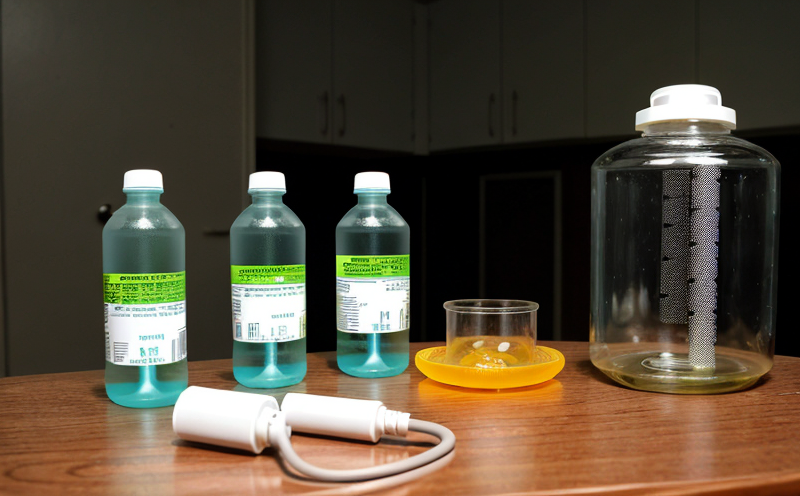ISO 18589-2 Radionuclides Gamma Spectrometry Test in Water
The ISO 18589 series of standards provides methods for determining radionuclides in water by gamma spectrometry. Specifically, the ISO 18589-2 standard focuses on the analysis of radionuclides using high-purity germanium (HPGe) detectors or other suitable detectors capable of detecting low-energy gammas. This service is critical for ensuring compliance with regulatory requirements and safeguarding public health.
The primary purpose of this test is to measure the concentration of specific radionuclides in water samples, which can originate from various sources such as nuclear accidents, industrial discharges, or naturally occurring radioactive materials (NORM). The test covers a range of radionuclides including but not limited to iodine-131, cesium-134, and cesium-137. The accuracy and precision of the results are paramount for regulatory compliance and environmental protection.
The testing process involves several key steps: sample collection, preparation, and analysis using gamma spectrometry. Samples are collected from various locations and sources to ensure a representative dataset. After collection, samples are prepared by filtering or diluting them as necessary before they undergo the actual measurement process. The HPGe detector is used to measure the gamma-ray emissions from the radionuclides present in the sample.
The acceptance criteria for this test are strictly defined according to ISO 18589-2. Results must be reported with a specified level of precision and accuracy, typically within ±3% relative error or better. The final report includes not only the measured concentrations but also detailed information about the method used, sample preparation steps, and any corrections applied during data analysis.
The importance of this test cannot be overstated. It plays a crucial role in ensuring that water supplies are safe for consumption by the public. Regulatory bodies such as the World Health Organization (WHO) and the United States Environmental Protection Agency (EPA) have set thresholds for radionuclide levels in drinking water, and these tests help ensure compliance with those standards.
Moreover, this testing service is vital for environmental monitoring efforts aimed at identifying and mitigating potential risks associated with radioactive contamination. By providing accurate data on the presence and concentration of radionuclides in water samples, decision-makers can take appropriate actions to protect human health and the environment.
In conclusion, ISO 18589-2 Radionuclides Gamma Spectrometry Test in Water is an essential tool for ensuring safe and compliant water supplies. Its rigorous standards and precise measurement techniques make it a cornerstone of quality assurance programs in this sector.
Why It Matters
The ISO 18589-2 Radionuclides Gamma Spectrometry Test in Water is crucial for several reasons. Firstly, it helps maintain public health by ensuring that water supplies meet stringent safety standards set by regulatory bodies worldwide. Secondly, this test supports environmental protection efforts aimed at minimizing the impact of radioactive contamination on ecosystems and wildlife.
Regulatory compliance is another significant reason why this service matters. Many countries have established maximum permissible levels for radionuclide concentrations in drinking water as per international guidelines like WHO and EPA standards. Compliance with these regulations not only prevents legal penalties but also builds trust among consumers regarding the safety of their water supply.
From an operational perspective, regular testing ensures early detection of potential issues that could lead to costly shutdowns or recalls if left unaddressed. Early intervention allows for targeted corrective measures, thereby minimizing disruptions and associated costs.
In summary, the ISO 18589-2 Radionuclides Gamma Spectrometry Test in Water is vital for maintaining public health, supporting environmental protection initiatives, ensuring regulatory compliance, and facilitating smooth operations within water management systems.
Why Choose This Test
Selecting the ISO 18589-2 Radionuclides Gamma Spectrometry Test in Water offers numerous advantages over other testing methods. One key benefit is its high sensitivity, which allows for precise detection of even trace amounts of radionuclides in water samples.
- Precise measurement down to picogram levels
- High repeatability and reproducibility ensuring consistent results
- Ability to analyze a wide range of radionuclides simultaneously
- Compliance with international standards ensuring reliability and acceptance globally
- Rapid turnaround times allowing for timely decision-making
Another advantage is the detailed reporting capabilities provided by this service. The comprehensive reports generated include raw data, calculated concentrations, and interpretative comments tailored to meet specific user needs.
Furthermore, choosing this test ensures that you are working with experienced professionals who understand both the technical aspects of gamma spectrometry as well as the broader implications for public health and environmental safety.
In summary, selecting the ISO 18589-2 Radionuclides Gamma Spectrometry Test in Water offers unparalleled precision, reliability, versatility, compliance assurance, rapidity, and detailed reporting. These factors make it an ideal choice for organizations committed to maintaining high standards of water quality.
Use Cases and Application Examples
- Regulatory Compliance: Ensuring that water supplies meet stringent regulatory requirements set by agencies like WHO, EPA, and local authorities.
- Environmental Monitoring: Identifying areas affected by radioactive contamination due to industrial accidents or natural events.
- Nuclear Plant Operations: Regularly testing water used in nuclear power plants to detect any leaks or spills that may have contaminated nearby watersheds.
- Drinking Water Treatment Plants: Monitoring the effectiveness of treatment processes designed to remove radionuclides from raw water before distribution.
- Research Laboratories: Conducting fundamental research into the behavior and transformation pathways of radionuclides in aquatic environments.
- Emergency Response: Rapidly assessing contaminated waters following natural disasters or terrorist attacks involving nuclear materials.
The versatility of this test makes it applicable across various industries including municipal water utilities, private drinking water providers, and environmental consulting firms. Its ability to detect trace levels of radionuclides ensures that even minute quantities can be identified and addressed promptly.





